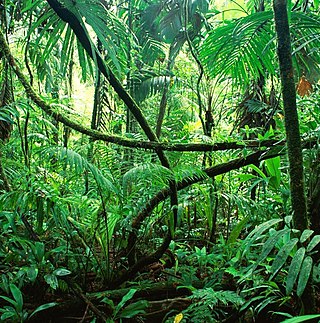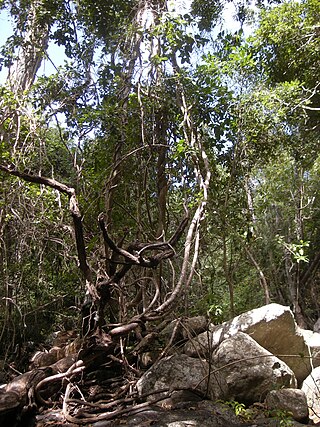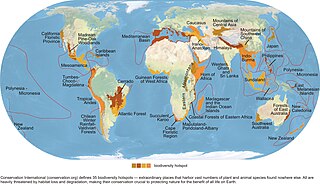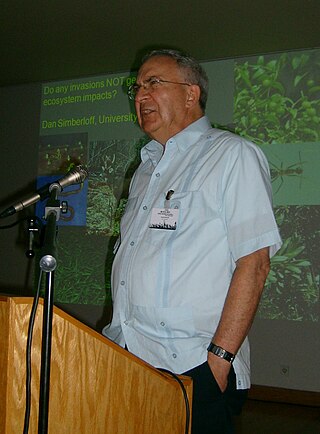
Deforestation or forest clearance is the removal of a forest or stand of trees from land that is then converted to non-forest use. Deforestation can involve conversion of forest land to farms, ranches, or urban use. The most concentrated deforestation occurs in tropical rainforests. About 31% of Earth's land surface is covered by forests at present. This is one-third less than the forest cover before the expansion of agriculture, with half of that loss occurring in the last century. Between 15 million to 18 million hectares of forest, an area the size of Bangladesh, are destroyed every year. On average 2,400 trees are cut down each minute.

Thomas Eugene Lovejoy III was an American ecologist who was President of the Amazon Biodiversity Center, a Senior Fellow at the United Nations Foundation and a university professor in the Environmental Science and Policy department at George Mason University. Lovejoy was the World Bank's chief biodiversity advisor and the lead specialist for environment for Latin America and the Caribbean as well as senior advisor to the president of the United Nations Foundation. In 2008, he also was the first Biodiversity Chair of the H. John Heinz III Center for Science, Economics and the Environment to 2013. Previously he served as president of the Heinz Center since May 2002. Lovejoy introduced the term biological diversity to the scientific community in 1980. He was a past chair of the Scientific Technical Advisory Panel (STAP) for the Global Environment Facility (GEF), the multibillion-dollar funding mechanism for developing countries in support of their obligations under international environmental conventions.

Rainforests are forests characterized by a closed and continuous tree canopy, moisture-dependent vegetation, the presence of epiphytes and lianas and the absence of wildfire. Rainforests can be generally classified as tropical rainforests or temperate rainforests, but other types have been described.

A liana is a long-stemmed, woody vine that is rooted in the soil at ground level and uses trees, as well as other means of vertical support, to climb up to the canopy in search of direct sunlight. The word liana does not refer to a taxonomic grouping, but rather a habit of plant growth – much like tree or shrub. It comes from standard French liane, itself from an Antilles French dialect word meaning to sheave.

Daniel Hunt Janzen is an American evolutionary ecologist, and conservationist. He divides his time between his professorship in biology at the University of Pennsylvania, where he is the DiMaura Professor of Conservation Biology, and his research and field work in Costa Rica.

Habitat destruction is the process by which a natural habitat becomes incapable of supporting its native species. The organisms that previously inhabited the site are displaced or dead, thereby reducing biodiversity and species abundance. Habitat destruction is the leading cause of biodiversity loss. Fragmentation and loss of habitat have become one of the most important topics of research in ecology as they are major threats to the survival of endangered species.

Daniel Simberloff is an American biologist and ecologist. He earned his Ph.D. from Harvard University in 1969. He is currently Gore Hunger Professor of Environmental Science at the University of Tennessee, editor-in-chief of the journal Biological Invasions, and a member of the National Academy of Sciences.

In biology, the canopy is the aboveground portion of a plant cropping or crop, formed by the collection of individual plant crowns. In forest ecology, canopy refers to the upper layer or habitat zone, formed by mature tree crowns and including other biological organisms. The communities that inhabit the canopy layer are thought to be involved in maintaining forest diversity, resilience, and functioning. Shade trees normally have a dense canopy that blocks light from lower growing plants.
Mongabay (mongabay.com) is an American conservation news web portal that reports on environmental science, energy, and green design, and features extensive information on tropical rainforests, including pictures and deforestation statistics for countries of the world.
The Parker/Gentry Award, established in 1996 and presented annually by the Field Museum of Natural History, honors an outstanding individual, team or organization in the field of conservation biology whose efforts have had a significant impact on preserving the world's natural heritage and whose actions and approach can serve as a model to others. The award is designed to highlight work that could benefit from wider publicity and fuller dissemination of scientific results.

Rates and causes of deforestation vary from region to region around the world. In 2009, two-thirds of the world's forests were located in just 10 countries: Russia, Brazil, Canada, the United States, China, Australia, the Democratic Republic of the Congo, Indonesia, India, and Peru.
Palm oil, produced from the oil palm, is a basic source of income for many farmers in South East Asia, Central and West Africa, and Central America. It is locally used as cooking oil, exported for use in much commercial food and personal care products and is converted into biofuel. It produces up to 10 times more oil per unit area than soybeans, rapeseed or sunflowers.

Deforestation in Indonesia involves the long-term loss of forests and foliage across much of the country; it has had massive environmental and social impacts. Indonesia is home to some of the most biologically diverse forests in the world and ranks third in number of species behind Brazil and the Democratic Republic of Congo.

Deforestation in Borneo has taken place on an industrial scale since the 1960s. Borneo, the third largest island in the world, divided between Indonesia, Malaysia and Brunei, was once covered by dense tropical and subtropical rainforests.

Avoided Deforestation Partners, or AD Partners, is a non-profit organization under the auspices of the Center for International Policy in Washington, D.C. AD Partners is involved in the global effort to solve climate change by working to end deforestation in tropical rainforest countries. By avoiding the practice of deforestation, i.e., clearing forests to provide inexpensive farmland, the world gains the significant climate benefits of not releasing carbon into the atmosphere. In addition, avoiding deforestation also allows forests to sequester carbon and scrub the air of pollutants. Beyond protecting the Earth's air quality, tropical forests facilitate conditions for rain, replenish water sources, provide habitats for myriad plant and animal species, and sustain the livelihoods of 1.6 billion people globally. Leading scientists and economists say that ending deforestation is the most cost effective and scalable method of reducing greenhouse gases. In fact, they believe that ending deforestation will cut the timeframe for solving the climate crisis in half.

William F. Laurance, also known as Bill Laurance, is Distinguished Research Professor at James Cook University, Australia and has been elected as a Fellow of the Australian Academy of Science. He has received an Australian Laureate Fellowship from the Australian Research Council. He held the Prince Bernhard Chair for International Nature Conservation at Utrecht University, Netherlands from 2010 to 2014.

Lian Pin Koh is a Singaporean conservation scientist. He is the Kwan Im Thong Hood Cho Temple Professor of Conservation, Vice Dean of Research at the Faculty of Science, Director of the Centre for Nature-based Climate Solutions, and Director of the Tropical Marine Science Institute at the National University of Singapore (NUS).

Road expansion refers to the increasing rate at which roads are constructed globally. Increases in population size and GDP, particularly in developing nations, are the primary drivers of road expansion but transportation planning decisions also play an important role. The anticipated length of newly paved roads to be built between 2010 and 2050 would encircle the planet more than 600 times. Approximately 90% of the new roads are being built in developing nations. Africa and Southeast Asia are predicted to experience a large amount of road expansion shortly.
Rodolfo Dirzo is a professor, conservationist, and tropical ecologist. He is a Bing Professor in environmental science at Stanford and a senior fellow at the Stanford Woods Institute for the Environment. His research interests mainly focus on plant-animal interactions, evolutionary ecology, and defaunation in the tropics of Latin America, Africa, and the Central Pacific. He was a member of the Committee on A Conceptual Framework for New K-12 Science Education Standards, co-authoring the framework in 2012, and continues to educate local communities and young people about science and environmental issues.
Nadine Therese Laporte has been a researcher and professor of forestry and remote sensing for over 30 years. She is adjunct research professor at Northern Arizona University. Prior to becoming a scientist at the Woods Hole Research Center, where she was director of the Africa program, she conducted postdoctoral research at the University of Maryland in College Park and NASA’s Goddard Space Flight Center in Greenbelt Maryland. Laporte's research contributed to tropical forest policies a part of REDD+ REDD+ is a policy mechanism to reduce carbon emissions by helping to protect tropical forests and lessen deforestation. She assisted the government of the Democratic Republic of the Congo to quantify forest carbon stocks and emissions reporting for REDD+ under the UN Framework Convention on Climate Change (UNFCCC). This method was suggested because it would help protect biodiversity, people living in the area, and maintaining stored carbon in these tropical ecosystems.















